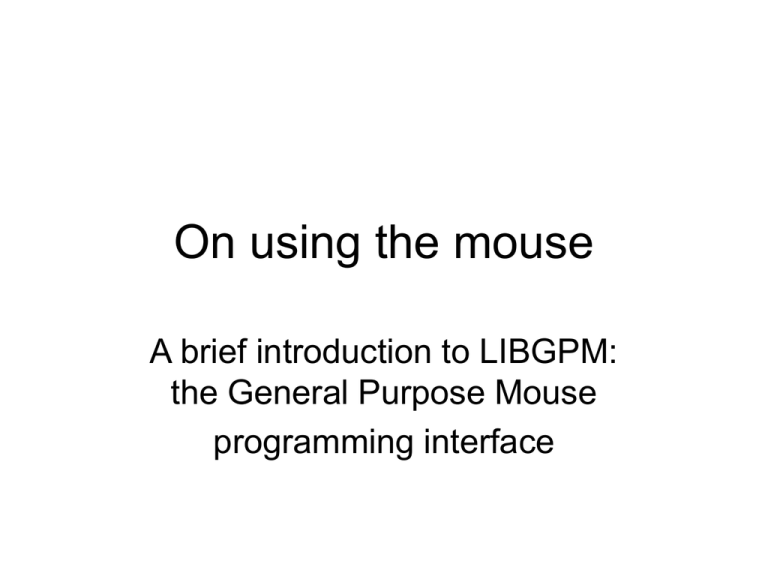On using the mouse A brief introduction to LIBGPM: programming interface
advertisement

On using the mouse A brief introduction to LIBGPM: the General Purpose Mouse programming interface Diversity of hardware • As with SVGA devices, there are computer mice from a diversity of vendors – and no universal standard hardware design • The customary solution: a software layer is created which ‘hides’ hardware differences • For Linux platforms, the ‘libgpm’ package provides one such software-layer – though it was intended for text-based applications Example: the PS/2 Mouse The Mouse Report Format (3 bytes) 7 Byte 0 6 5 4 Y-data X-data Y-data X-data over over sign sign flow flow 3 0 2 1 0 Middle Right Left Button Button Button down down down Byte 1 X-coordinate data (bits 7..0) Byte 2 Y-coordinate data (bits 7..0) Other types of computer mice use different report formats with possibly a different number of bytes (e.g., 4 or 5) The Linux “gpm” package • • • • • • • It’s a mouse server for the Linux console It “hides” details about mouse hardware Intended for use with text-based programs But we can use it with graphics programs Requires that the gpm daemon is running Type ‘info gpm’ to see official information Also an online article by Pradeep Padala Programming steps • Your client application must establish a connection with the gpm server-daemon • You need a header-file: #include <gpm.h> • You declare an important data-structure: Gpm_Connect conn; • You will need to initialize its four fields • Then you call Gpm_Open( &conn, 0 ); • Returns -1 if unsuccessful (otherwise 0) Fields to be initialized conn.eventMask = ~0; conn.defaultMask = 0; conn.minMod = 0; conn.maxMod = ~0; // events of interest // to handle for you // lowest modifier // highest modifer Responding to mouse activity • You create your own ‘handler’ function for those mouse events that you wish to act upon • Prototype of the handler-function is: int my_handler( Gpm_Event *evt, void *my_data ); • To install the handler, use this assignment: gpm_handler = my_handler; • Whenever the mouse is moved, or its buttons are pressed or released, your function executes Useful fields in Gpm_Event Gpm_Event *evt; evt->type == 1: // indicates a mouse-move evt->x, evt->y: // current mouse ‘hot-spot’ evt->dx, evt->dy: // changes in position(+/-) NOTE: Remember that GPM was developed for text-based applications, so the hot-spot coordinates are character-cell locations (not graphics-pixel locations) The GPM mouse-event mask #include <gpm.h> L E A V E E N T E R H A R D M O V C L K T R I P L E D O U B L E S I N G L E U P D O W N D R A G Your event-handler function will ‘test’ one or more of these flag-bits to determine what type of state-change the mouse has undergone, so that your application can respond to it in an appropriate manner M O V E A typical program loop This loop allows normal keyboard input to continue being processed (e.g., echoed, buffered) while any mouse activities are processed by your handler (or else by a default handler supplied by the daemon) int c; while ( ( c = Gpm_Getc( stdin ) ) != EOF ); Gpm_Close(); A simple text-mode demo • Pradeep Padala has published a short C program that illustrates ‘barebones’ usage of the gpm package (from Linux Journal) • We have adapted his code for C++ • Our demo is called ‘trymouse.cpp’ • It’s compiled like this: $ g++ trymouse.cpp –lgpm –o trymouse A simple graphics demo • We have created a minimal graphics demo • It shows how you could use the mouse to move a ‘slider’ object (e.g.,in Pong game) • It’s called ‘gpmslide.cpp’ • You compile it like this: $ g++ gpmslide.cpp –lgpm –o gpmslide More elaborate graphics demo • We also created a more elaborate mousedemo (called ‘seemouse.cpp’) • It defines its own custom mouse-cursor • It handles the four most common types of mouse events: – GPM_MOVE – GPM_DOWN – GPM_DRAG – GPM_UP Our mouse cursor • We built a 2-color 16-by-16 pixel image We used an array of character-strings to define our image with only three character-values ‘0’ = transparent color ‘1’ = background color ‘2’ = foreground color Our mouse cache • Each time we want to draw our cursor, we first copy the existing 16-by-16 pixel-grid that occupies the planned cursor-location • Then we can draw our cursor threre • When the mouse is moved, we need to ‘erase’ our cursor-image (by copying the saved background there), and then saveand-draw our cursor in the new location In-class exercise #1 • Can you create a different cursor-image, based on your own design ideas? Will your design define a different ‘hot-spot’? Will you need to modify the boundaries to keep your cursor from going out-of-view? Demo: ‘persists.cpp’ • We created a sound-playing program that plays a continuous tone – until a ‘signal’ is received (asynchronous notification) that the user has pressed the <ESCAPE> key • We used an ‘ioctl’ command to ‘RESET’ the playback device – to stop the tone’s sound almost immediately when our user presses the <ESCAPE> key In-class exercise #2 • Try commenting out the final ‘ioctl’() call in our ‘persists.cpp’ demo, then recompile it and execute that demo again. Does the sound cease immediately? • Can you incorporate the sound-effect into our ‘seemouse.cpp’ demo, so that a user can start the tone by pressing the mousebutton, and stop the tone by releasing it?

